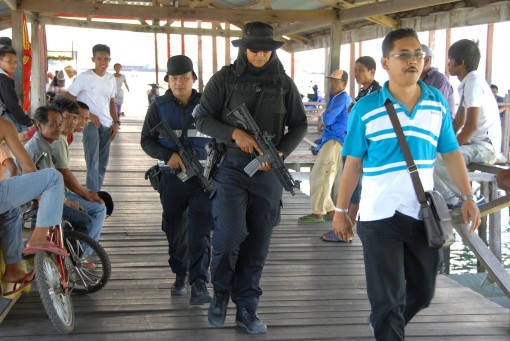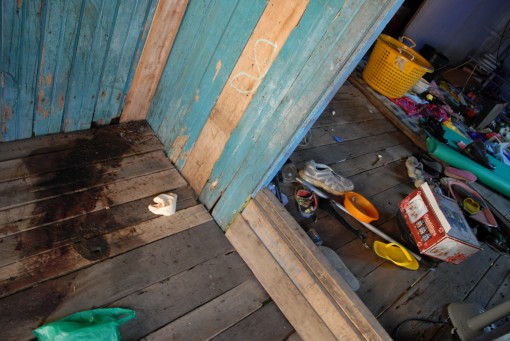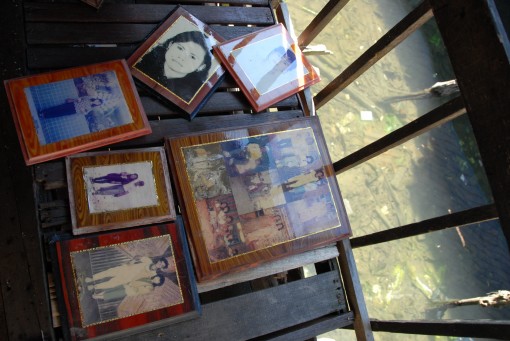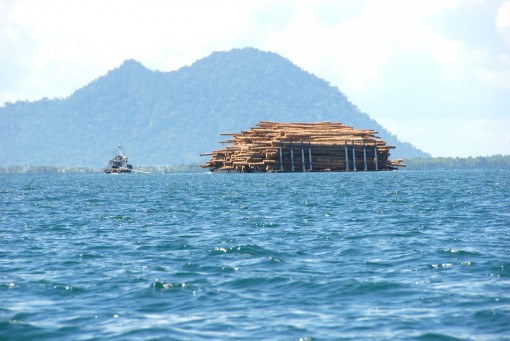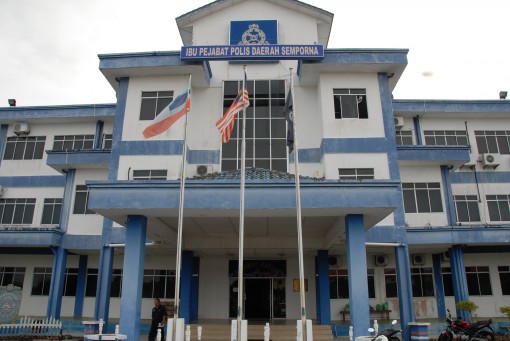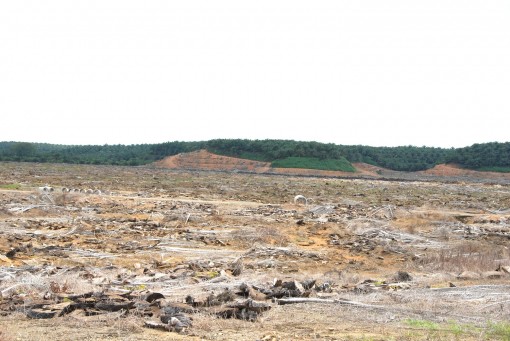One ordinary day, precisely, February 9th, 2013, a band of brigands (if you listen to Malaysian authorities), or heroic liberators (as some nationalist Filipinos living in both the Philippines and in Malaysia would say), or simply mildly deranged and overly romantic buccaneers (according to most people at both sides of the Sulu Sea), landed their crafts on the green, palm-oil-plantation-covered shores of Sabah and immediately got themselves busily engaged in chivalrous warfare against the Malaysian nation, with the luminous goal of bringing the state of Sabah back under the reign of the Sulu Sultanate.
To be ‘precise’, it is often quoted that exactly 235 Filipinos (where that precision comes from is a mystery to me), some armed, some not, had travelled from Tawi-Tawi in the Southern Philippines, to the dormant, and, as many would say, god-forsaken town of Lahad Datu, in Sabah, Malaysia.
Their commander, Agbimuddin, is a brother of the self-proclaimed Sulu “sultan”, Jamalul Kiram III.
Those facts could be determined, confirmed and even re-confirmed; those fact alone, but not much more. After that, everything suddenly becomes a shadow play, something that would be more appropriate in the heart of Central Java in neighboring Indonesia, than in the grotesquely over-developed Malaysian-controlled Borneo, covered by a monoculture of palm oil plantations.
Where did this romanticism come from? Sabah, with oil, palm oil and unbridled logging could be easily described as one of the most pragmatic, un-quixotic parts of Southeast Asia. And Sulu itself has been playing bizarre international games for years and decades.
But suddenly those few, those 235 maritime samurais, were arriving from the isles, and from a different era, ready to fight for honor and even to die, facing the entire Malaysian state, one of the richest in Southeast Asia, with its 29 million inhabitants.
“How daring!” Say some, while others offer a more pragmatic view: “How idiotic!”
There are more questions than answers. Who is really behind this ‘war’? Were leaders of the Sulu Sultanate calling for the attack; were they the ones who issued the orders? And while both Malaysia and the Philippines are presently submerged up to their ears in rather serious political crises, could that situation be somehow connected to the Sabah mêlée, and could some political forces be thinking that they might benefit from the conflict?
And what about the history; how is it interlaced with the present? Current geopolitical arrangements are, undeniably, the result of British post – WWII colonialist schemes, just as they are the result of the brutal oppression of left-wing forces in the entire region.
Historically. Sabah used to belong to the once powerful but now defunct Sulu Sultanate, which is now part of the Philippines.
Leading academician, Eduardo C. Tadem, Professor from the University of Philippines in Manila, puts things to perspective:
“I have to highlight the principle of self-determination for the Sabah people. It is a historical fact that the Sabahans were never consulted in 1962 or 1963 a whether they wanted to be part of the Malaysian Federation. The Cobold Commission may, in all probability, have just fabricated the formula ‘30-30-30’. As for the Philippine claim, it rests on the moribund Sulu Sultanate’s assertion of sovereignty based on the grant by the Sultan of Brunei in return for a favor in helping suppress a native rebellion. In my book, while the transfer may have been ‘legal,’ there is no moral basis for it. Everything then turned murky. Arguing over whether the acquisition by the British of Sabah from the Sulu sultan was a lease or a cession merely trivializes the whole affair.”
“There was an attempt at self-determination in 1962 when the left-wing Brunei People’s Party led by Azahari launched a rebellion in an attempt to unify Sabah and Brunei under a nation-state independent of both Malaysia and Philippines. British forces with the help of Gurkha mercenary troops swiftly crushed this rebellion. Incidentally, at the time they launched the rebellion, the Brunei People’s Party had popular support having won all the contested seats in the local legislature. Then President Sukarno may have had a hand in this rebellion as Azahari took refuge in Jakarta and died there years later. Then as now, therefore, what matters is what the residents of Sabah want, not what the Manila and KL governments desire.”
And one would hope, not what the Brits wanted… Although, in Malaysia, no matter how fiery and anti-imperialist the rhetoric of Dr. Mahathir used to be, the Brits never really left the psyche and imagination of a substantial part of local ‘elites’. This group of dogged anglophiles has been hopelessly enamored with the Empire; with their former colonial masters, even when the boot had been planted squarely onto the behinds of the local people of the region.
The Brits naturally considered ‘self-determination’ to be one of the filthiest expressions that ever penetrated English language.
The ‘war’ began as an operatic, even burlesque occurrence.
More than 200 men were hiding deep in the jungle, or in the rubber plantations, or in the dwellings in several stilt villages, ready to strike mighty Malaysia. Who would not immediately recall an iconic 1959 film with Peter Sellers: “The Mouse That Roared”, about that tiny, poor, imaginary country in the middle of Alps, called “Duchy of Grand Fenwick”, which declared war against the United States because the Empire refused to buy its ‘Pinot Grand Fenwick’ wine? Troops with bows and arrows were sent on board commercial flight to New York. Their mission is to get defeated and secure a miniature version of the Marshall Plan. Instead, through a terrible mistake, the army of Grand Fenwick defeats the Empire.
But in Sabah, fun did not last long and there was no Peter Sellers to turn the whole thing in to a circus.
People began dying. Clashes between ‘invaders’ and the police began, and the Malaysian armed forces got heavily involved. Large areas were sealed and declared out of reach for local and foreign journalists, for ‘their own protection’, naturally, Indonesian-style.
Tanks and armored vehicles were suddenly rolling down the roads of Sabah, and Malaysia scrambled fighter jets, bombing relentlessly ‘infiltrated’ areas from the air, and then deploying heavily-armed troops to ‘finish the job’.
The number of victims is absolutely unknown. Suddenly, all this turned into damn serious stuff, with tens of thousands of people displaced, on the move.
Manila Standard Today reported that by the end of March 2013, at least 12 battalions of Malaysian soldiers and policemen, or more than 7,000 men, were searching for Agbimuddin and his men.
By the end of the month of March, according to official counts, at least 73 people died in the battles – 63 Sulu insurgents, eight Malaysian policemen and two soldiers.
Or this is what the public has been told.
Combatants are not the only victims, and official Malaysian statistics name no civilian casualties.
But at least 4,000 Filipino men, women and children fled Sabah, fearing for their lives. From my own investigation, the real number of those who left Malaysia, as well as those who have been in hiding in Borneo, could easily reach the tens-of-thousands, at the most conservative estimate.
“We are scared”, whispers a lady selling basic foodstuff in the heart of a humble stilt village, which saw, recently, a series of brutal exchanges between insurgents and Malaysian police.
“We are scared”, whisper three boys, who are only in their early teens. They are taking me around, pointing at the places where some of the most gruesome killings took place. We are flouting all security precautions, as we dash into the houses abandoned by their inhabitants, then walking on wooden, elevated walkways, some of them badly damaged, some still bearing clearly visible bullet marks and blood stains. This is where people, some militants and some police officers, had been shot, others hacked to death or decapitated alive. “We don’t know who is watching us now, or who is listening,” murmur the boys. “Just take photographs quickly, and let’s get out of here, please!”
“I am scared”, shouts a boatman over the roar of his engine, navigating small high-speed craft between seemingly endless forests of stilts. “I am not refusing to take you around; we can sail under the houses for hours, but I don’t dare to land here. You can disembark one kilometer away and walk back to this town. Please understand: there are commandos inside this kampong. If they see me land, I could lose my license, I could be captured, I could be questioned and interrogated.”
“Could they disappear you?” I ask.
He pretends not to hear my question.
“Philippine people are scared and they had to flee”, I am told by a driver who agrees to take me to the overblown police station at the outskirts of Semporna City. “Thousands of them had to flee. They have been petrified since ‘the events’. It is like an exodus!”
In the morning, as I sit by the water, in a local café, an old man walks slowly towards my table. “What are you doing here?” He asks. I point at my massive professional camera resting on top of the table, making acquaintances with the fresh carrot juice. “So now it came to that,” comments the grandpa, sadly. “International press in this town, that used to be visited only by divers and adventurers.”
“Are you also scared?” I ask him, because everybody else seems to be. “Yes I am”, he nods.
“Of whom?” I ask.
He does not reply.
“Of whom?” I insist.
He leaves, abruptly.
The old man forgot to mention that for years and decades before the conflict, it was not just divers and adventurers, but mainly hundreds of thousands of legal and illegal migrant workers, predominantly from the Philippines, but also from India, Indonesia, Bangladesh and elsewhere, who have been coming to Sabah, in search of relatively well-paid jobs.
He also forgot to say that this was not so ‘unexpected’, that it was not the first ‘incident’. At least 21 Lahad Datu inhabitants were killed when Sulu pirates invaded the shores of Sabah and looted local bank and Malaysian Airlines office in 1985. And there were kidnappings, later, from the Sandakan area.
Sabah, with its, by the region’s standard, high salaries, has been like a strong magnet for migrants arriving from the Philippine islands of Mindanao, Basilan and Sulu, and from the Indonesian parts of Borneo called Kalimantan, both areas easily definable as some of the poorest in Southeast Asia. Remittance stores in Sabah’s cities openly advertise the transfer of funds to the Philippines, India, Bangladesh, Indonesia and several other countries that are regularly sending millions of workers to much richer parts of the world.
Before the recent ‘war’, there was a Filipino migrant community living in Sabah over 800,000-strong, the majority without official papers and therefore vulnerable to exploitation and abuse.
All this created confusion, tension and even open hostility and discrimination, something that was always very well concealed.
There were anti-immigrant lobbies and pro-immigrant ones; there were those who wanted to keep Sabah predominantly ‘native’ and ‘Malaysian’, as well as those who were interested on getting their hands on as many immigrants as possible, in order to take advantage of cheap and badly organized labor.
Hardly anybody came here because of love for the place: Sabah state is not only humid and hot; it is filthy, and outrageously boorish. Here, one could easily forget that this is Malaysia, a middle-income country that has aspired (for decades), to join the so-called developed world.
With garbage-covered streets, rubbish floating next to and off the seashores, with children begging at food markets and street corners, the cities of Sabah resemble some Philippine or Indonesian urban centers, with primitive or collapsed infrastructure, an acute lack of hygiene, public transportation and appalling social policies.
It is not only the outsiders who are noticing the rot. The opposition State Reform Party claimed, recently, that Sabah health care is in a deplorable condition, everywhere; in some cases it says it is unacceptable. There is a feeling of thorough hopelessness here, mostly unknown in the rest of the country, especially in the glitzy and cosmopolitan Kuala Lumpur or elegant, historic and ‘oh so’ Chinese cities like Georgetown on Penang Island or Kuching in Sarawak.
Sabah used to be the second richest state in Malaysia, after Selangor, at least on paper, and mainly due to its unregulated logging and later introduction of palm oil plantations. Those have been managing to ruin almost all of state’s native fauna and flora, turning it into near Indonesia-style environmental nightmare, but the earnings used to be high.
Lately the greed, mismanagement, and unequal distribution of wealth, has turned Sabah into the second poorest state of Malaysia. Apart of palm oil, Sabah also produces crude oil, but, like in the Gulf, the natural wealth of the area does not necessarily translate into prosperity for the majority of the inhabitants. Children here are often running barefoot and many adults appear to be illiterate. It is not only medical care that is in disastrous state; it is also education.
I get to work, trying to collect as many testimonies from the ground as possible. There seems to be no foreign press in the city of Semporna; all journalist left soon after the first wave of fighting subsided.
This is the area that registered the largest number of Malaysian casualties, most likely 6, but possibly much more.
There are several theories about what happened. The most accepted one is that on 2 March 2013, ten alleged insurgents were holed inside a house in a humble stilt village at Simunul, concretely in its dilapidated section called Lorong 5, and that they were discovered by police. That’s what I am told by the locals; those few who are still left here; those who dared not to abandon their homes.
One of the local kids, Azman bin Ahmad is my self-designated guide. His grandparents came from Sulu, but he feels Malaysian. I don’t ask for it, but he insists on flashing his official Malaysian ID at me, repeatedly, as if feeling the need to prove his own identity to himself, to me and to the world.
Azman and his mates are taking me through Lorong 5, to the house where the gruesome exchange took place. Elevated, stilt-supported walkways form a complex, fascinating labyrinth.
“There was terrible battle right at this place”, explains Azman. “Just look at those marks! They are all over and they are from the bullets. And, here – see the blood? At one point, police officers and insurgents all fell to the water… And the water was red from blood. It was just awful…”
I ask Azman and his friends to explain exactly what happened here.
“There were some 10 or more people gathering here, inside the house. They were all from Sulu. During the prayer time, between Maghrib and Isha (between 6:30pm and 7:30pm), they were conducting ‘tahlil’, a prayer for those who died earlier in the battle at Lahad Datu, some 200 kilometers away from here; from Semporna. Then a group of police officers moved in; they were progressing towards the house, obviously tipped off by locals. Police were armed. One of them kicked the door of the house open… Then everything began happening with the lightning speed: several men were behind the door. They grabbed the nearest police officer and killed him on the spot. After that, many shots were fired. I don’t know who was firing at whom, but I think that the shooting was coming from both sides. They say that six police officers died as well as three or more of Sulu people. You can see there, and there, where the bullets hit the walls.”
One of the boys jumps in, impatiently. He goes ballistic, arguing that the Sultan of Sulu is not really a sultan, and how the fighters who landed in Sabah had been fooled; how all that has been happening is one huge farce.
Whether farce or not, the scene of the worst documented battle of this conflict definitely looks eerie. Stilt walkways collapsed; some parts are submerged, broken, and there is nobody around.
I peek into the houses and everything inside them is upside down, torn apart and smashed; in absolute disarray.
“Malaysian commandos came here on several occasions, and destroyed everything”, explains one of the boys.
There are some family photos on the wooden bench, left intact. These are images of content looking men, women and children, posing with warm smiles on their faces. ‘What happened to them?’ I think. This is the house where the killings took place. ‘What is really going on?’
People on the photographs do not look at all threatening.
It appears that nobody in Kuala Lumpur and in Manila actually understands what is going on here. And it appears that it is supposed to remain like that.
Irwanizam bin Mad Jais, a Bajau native, is also confused by the present situation:
“The majority of citizen of Semporna are Bajau and Suluk people. Many came from Sulu and then settled here. Some of them have already lived in Sabah for more than 10 years, and are in possession of ID (IC) cards. They are definitely not some kind of ‘outsiders’“.
When I ask about the battle in Semporna; at Simunul, Lorong 5, he immediately voices his doubts:
“I heard that three or more policemen died in the fights at Kampung Simunul. They were sent here from Serawak and from Kuala Lumpur. There are some things that I don’t comprehend: the government has been saying that the attackers who died all came from Sulu, that they were followers of Sultan of Sulu. What I know is that Sulu fighters usually wear elaborate and scary uniforms, and they are armed. I saw with my own eyes those people who died in Lorong 5, and were later called ‘Suluk fighters’ by the government. They didn’t wear any uniforms. Three dead bodies carried out of the village by the police were wearing traditional Malay clothes. It appeared as if they were just woken up from their sleep, killed, and immediately carried away. And there were no guns. I don’t understand why the police killed these three men. Frankly, I don’t think they were the insurgents.”
I ask him about police brutality:
“There is plenty of it now. I don’t understand why police tends to be so violent towards the common people here? They are conducting frequent raids. And we are afraid because they are carrying guns. I am a citizen of Sabah. I have IC. I make money by driving my own car. But they are questioning me, and my friends, as if we were a bunch of criminals. Why don’t they catch and punish real criminals and those who want to take over our State?”
I am told that Malaysian police brutality in Sabah is taboo; it is scarcely investigated and almost never mentioned in local media reports.
In Kuala Lumpur, Malaysian college lecturer and filmmaker, Kia Meng Boon, later explained:
“Peninsula Malaysians lack access to independent media in the country, where citizens could learn the facts and judge the real situation on the ground for themselves.”
It is no secret that Malaysian media and intellectuals are not renowned for their courage. I was told by several of my friends and colleagues in Kuala Lumpur, that ‘the government has really made this into a security issue’ and commenting on the situation would ‘not be strategic.’
Predictably, police and armed forces on the ground have their lips sealed. I visited both gunboat docks, and one enormous police station where few dozens of captured militia members are allegedly held. The answers were invariable:
“We are very sorry, but we can not talk about those incidents at all. There are people with more authority than us who can enlighten you. For instance, you can go to Police Headquarters.”
I asked Nadira Ilana, Malaysian filmmaker, who is originally from Borneo, whether the battles are actually ‘real’. There are countless rumors in both the Philippines and Malaysia that political interests actually orchestrated the conflict.
“Not sure what the rumors are in Kuala Lumpur, but there are clearly many rumors in Sabah”, she replied. “I personally don’t think it was politically arranged. Both Malaysia and the Philippines are facing election years. I can’t imagine how this incident could help either party… Yes, the Sabah attacks were very much real. It’s not the first time Sulus have attacked Sabah but it may be the first time we’ve been attacked over the Sabah claim…”
Then she concluded: “I think the Sabah claim was laid dormant after the formation of Malaysia, which unintentionally and perhaps indirectly sparked the Mindanao-Philippines civil war. If it were not for Sabah’s Suluk Chief Minister Tun Mustapha, Malaysia and Libya, Mindanao would not have become an autonomous region. The Sulu claim on Sabah seems to fluctuate depending on Mindanao-Philippines relations, which is why I see these recent attacks as a spillover from Philippines’ politics rather than a BN ploy.”
It is quiet and peaceful at Café Melaka, on Semporna seafront. Two ladies wearing headscarves are watching a soap opera, as if there was no drama, much more gripping than a television one, consuming their state.
The scenery around is fantastic; traditional structures emerge from the sea, built on wooden supports. There are entire man-made islands resting on stilts, mostly inhabited by native sea-bound people who only opted for this ‘lifestyle compromise’ in recent years and decades. Mountains encircle the cove. There is a constant flow of slow and high-speed boats shuttling people between the Borneo mainland and the islands in the bay.
As I clean my camera lenses, slowly sipping bitter coffee, an old man I met earlier, returns. He is obviously eager to talk:
“It is terrible”, he sighs, refusing to sit next to me, as if ready to deliver memorized speech. “Here, we have no experience with such things. In other countries they would know what to do, but we are peaceful here. In Lahad Datu they had to face this situation in March, but we thought that here we would be spared. Suddenly, six police officers were murdered.”
‘Three or five or six’, I think. They cannot even agree on the numbers…
The old man continues his lament: “My friend told me that one entire commando had to come to retrieve bodies, because police would not dare to rescue corpses of their fallen comrades… I was also told that most of the officers were not shot; they were hacked to death, cut to pieces…”
At the end he gets philosophical: “In this part of the world, we may get the same color of hair, but who knows what is taking place inside our heads?” And he adds, laconically: “This also illustrates how thoroughly uneducated were the attackers. What did they think? That they would manage to capture the entire State of Sabah with that little band and their bare hands?”
There is only one tiny step from outrage to bigoted talk, even to discrimination itself.
The Filipino people, both those who have lived here for generations and those who came illegally, have mostly left the area. Lorong 5 is now half-empty – only Malaysians and some Indonesians stayed.
I hired a boat and went to the biggest island in the bay – Palau Bum-Bum – right across the water from Semporna. As I was arriving to jetty, mighty police speedboats were busy landing dozens of heavily armed men on the island.
I asked an Indonesian worker, a young girl named Zuraida, what happened to the Filipino people who have been living on the island for decades.
“Several of them used to work here, with us, but they are in hiding now. I have no idea where they went,” she said. I got the feeling that even if she would know, she would not tell, and for very good reasons.
The atmosphere, the mood all around Sabah is very bad. Most of the ‘foreigners’ have left, and some nationalist elements are now on the loose.
Pulau Bum-Bum is no exception. In very un-Malaysian and rude fashion, some minivan drivers speak to me in an obscene, insulting way: “Hey boss, hey you! Where you go?”
Heavily armed police move down the road.
Then the skipper who is taking me back to Sabah mainland is passing by ‘ice village’, where huge bricks of ice are waiting in awful heat to be transported to towns and villages all over the bay:
“People who are living in Lorong 5 have no clue about Malaysian law. They think here it is similar to what they have back at home – lawlessness. That’s why they think they can just come over and try to take Sabah. They are coming here from their proud and isolated sultanate, and they think that we – Malaysians – are lower then they are… And on top of that, their leaders in Sulu have tricked them by making promises that cannot be fulfilled!”
He goes on and on. Finally he begins sounding approximately the same as German neo-Nazis, and he is carrying quite a similar message. Except that he is speaking Malay.
Yes, the fear is everywhere. I walk to restaurant in a shack, near the road. One of the waitresses is married to a boy who used to live in Lorong 5.
I order a serving of awful fried noodles and ask her about her family. She studies me, for a while, then decides that I could be, most likely, trusted:
“My in-laws had to flee and to spend one entire week in hiding”, she explains.
“Has it been tough here for you?” I ask.
She nods. “There were tanks here. Big tanks, which you see in the movies… right here, on this road.”
On the way back to Tawau Airport, all that can be seen are enormous palm oil plantations. Their size is monstrous. The land is terribly scarred. There is no native forest left in the entire area, everything is logged out, destroyed. It is almost one hundred kilometers of uninterrupted and foreign monoculture.
“Do local people like this?” I ask the driver.
“Those who work in the industry – they do. The rest hate it. But what can they do?”
Tawau Airport is half-deserted. Like all over Sabah, people are sleeping with their heads on the table, including staff. Few kids are hanging around untidy eatery:
“With this conflict, I think business is down by 50%. You see that it is not as crowded as it used to be, and today is Friday, people used to travel a lot on this day… We have many Filipinos living here. We used to coexist in peace. Now there are prejudices on both sides…”
I got bumped off half-empty Malaysian Airlines flight. Their system jumped one month on my return ticket to Kuala Lumpur, not unusual occurrence for this airline with appalling customer service record. A check-in counter clerk shot his hateful glimpse at me, and then sent me, with spite, to nearby ticket office. There, inefficient and openly hostile agent began insulting me, before offering to re-instate the seat for approximately 300 dollars, three times the price of the original fare.
I flashed the gold card of One World alliance, which Malaysian Airlines recently joined, but they laughed in my face, and insulted me some more. I protested. Immediately, a couple of passengers stood up and threatened to call police. “There are children here”, they shouted at me. To protest injustice is obviously illegal here. I bought a one-way ticket on low-cost Air Asia and lost my Malaysian Airlines ticket altogether.
Sabah is overflowing with anger and bad moods, with bad will, frustration, concealed grievances, and both concealed and unconcealed violence.
The attacks were recent, but begging children, filth and destroyed environment are something that Sabah has been enduring for decades.
The medieval, feudal way in which the island of Borneo has been governed, as well as the cowardice of Malaysian intellectuals, many of whom are too comfortable, too lazy, too spoiled by Western funding and therefore thoroughly unwilling to address almost any uncomfortable issues in their country, are partially to blame for the set of nightmares that form the reality of the state of Sabah.
There are certain topics ‘ignored’ even by the opposition, unless some substantial financing from abroad is secured: like the savage logging practices exercised by Malaysian companies operating both at home and abroad, like the palm oil and ethnic/minorities issues. Naturally there are some exceptions; those individuals who are aiming at being little bit more than just some supermarket toy coin-horses, but sadly, very few.
The British colonial madness is also hardly addressed here, and its legacy is seen as some wise, even supreme type of guidance. This madness goes on and on, unchallenged and uncorrected.
The little invasion, the little war, will stop. Eventually, everything will calm down. After some year will pass, everything will be forgotten. Bizarre little wars and conflicts have tendency to parish from the memory of the people, especially if their roots are not analyzed and publicly debated.
Palm oil will probably make it, eventually, even to some city parks and private gardens. I would not be surprised if the palm oil plantations would be, one day, declared as inseparable part of Malaysian culture.
The Filipino community will keep enjoying ‘tolerance and lack of discrimination’, it was told to be enjoying by the Malaysian officials.
The regional political situation will continue to be confusing, even schizophrenic. To illustrate it: just a couple of days before the conflict, I was told by one of the Commanders of the Moro National Liberation Front (MNLF) that if the Sulu Sultanate ever demanded the return of Sabah to the Philippines, MNLF would fight leadership of the Sultanate. Instead, at one point after the invasion, MNLF declared that they ‘couldn’t stop their own fighters from joining the insurgents, anymore’.
In Malaysia, there will be no referendum on Sabah issue, or on any other essential matter. And there will be no serious revision of the colonial past despite the fact that it has been, periodically and nastily, merging with the present.
Andre Vltchek is a novelist, filmmaker and investigative journalist. He covered wars and conflicts in dozens of countries. His book on Western imperialism in the South Pacific – Oceania – is published by Expathos. His provocative book about post-Suharto Indonesia and market-fundamentalist model is called “Indonesia – The Archipelago of Fear” (Pluto). He just completed 130 minutes documentary film “Rwanda Gambit” about Rwandan history and the plunder of DR Congo. After living for many years in Latin America and Oceania, Vltchek presently resides and works in East Asia and Africa. He can be reached through his website.
